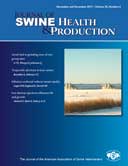Abstract:

Effects of social rank on welfare and performance of gestating sows housed in two group sizes
Yuzhi Z. Li, MSc, PhD; L. H. Wang, MSc, PhD; L. J. Johnston, MSc, PhD
Complete article is available online.
PDF version is available online.
Objectives: To compare welfare and performance among low-, middle-, and high-ranking sows in two group sizes of gestation pens.
Materials and methods: Pregnant sows (n = 152) were allocated to four pens of 26 sows (large-group pen) and eight pens of six sows (small-group pen) with floor feeding. Social rank was based on outcomes of aggression during mixing. Skin lesions were assessed for all sows and salivary cortisol concentrations were measured for 32 focal sows. Performance during gestation and lactation was recorded for all sows.
Results: Across the two group sizes, low-ranking sows fought less frequently, but had higher salivary cortisol concentrations and sustained similar skin lesions at mixing compared to high-ranking sows. Low-ranking sows had more skin lesions 5 weeks after mixing, gained less weight during gestation, and had lower body weight before farrowing than high-ranking sows. Social rank did not affect litter size farrowed, litter size weaned, or litter weight at weaning.
Implications: Under the conditions of this study, regardless of the group size adopted, low-ranking sows have poorer welfare than high-ranking sows in a group housing system with floor feeding, demonstrated by their having more skin lesions, higher cortisol levels, and less weight gain during the gestation period than high-ranking sows.
Keywords: gestation housing, social rank, sow, welfare
![]() Cite as: Li YZ, Wang LH, Johnston LJ. Effects of social rank on welfare and performance of gestating sows housed in two group sizes. J Swine Health Prod 2017;25(6):290-298.
Cite as: Li YZ, Wang LH, Johnston LJ. Effects of social rank on welfare and performance of gestating sows housed in two group sizes. J Swine Health Prod 2017;25(6):290-298.
Search the AASV web site for pages with similar keywords.
